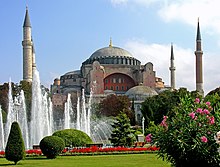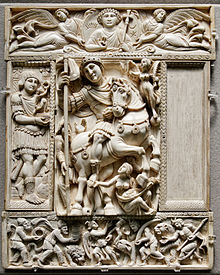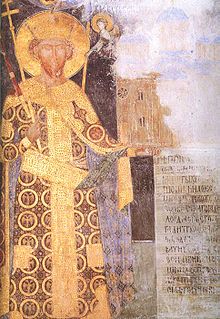Byzantine art



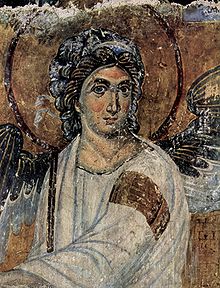
The Byzantine art is in particular the art of the Byzantine Empire , which existed from the 4th century to the 15th century. In addition, it also includes art in the Byzantine neighboring countries of the former empire in the Middle East , the Caucasus , the Balkans and the countries around the Caspian Sea and Russia . With that she outlasted the fall of Constantinople . But it also influenced the art of Latin Europe , in particular the early architecture of the Carolingians and Ottonians and the church architecture of the Upper Rhineland, as well as the panel painting of the High and Late Middle Ages in Italy, as well as the Marian painting of the late Gothic and early Renaissance in north-western Europe. She is known for her works of sacred architecture , enamel , textile , ivory and goldsmith art and is associated in particular with miniature , book , mosaic and icon painting .
The coverage of Byzantine archeology or art history by the scientific disciplines is not entirely uniform. It is often dealt with by the chairs of Christian archeology . In general, the history of the Byzantine Empire in Germany is often neglected.
introduction
The Byzantine art and culture that emerged from ancient art and followed the universal claim of Christian thought has deep roots among the Orthodox in Europe to this day . Since the Middle Ages, it has also formed a second pole to the Romanesque and Gothic art developing in Western Europe and still leads to an ideological and psychological demarcation of the peoples belonging to the Byzantine rite from the West. The Byzantine historical and cultural heritage of Europe has been neglected in the consciousness of Western societies and European identity. In particular, a negative attitude to Byzantine art in Western art criticism since Vasari was evidenced by the Epitome Maniera Greca .
The aftermath of the 'vasarian' devaluation of originality and evolution, in particular of Byzantine panel painting , remained effective through attributes such as rigidity , persistence and schematism , which should therefore assist the, in contrast, "free" Western artists and art styles with an artistic superiority, However, for a long time I was unable to correctly interpret the quality of the spiritualized world of Byzantine icons, frescoes and mosaics. The influential work of Edward Gibbons also had a discrediting effect on the Byzantine era, which was seen as the "millennial decline" of the Roman Empire, even in the decline of ancient art. It was only with modern and abstract painting at the beginning of the 20th century that the Byzantine painting tradition was assessed more positively and its image structure and image type also used as a template by Western artists, as well as the general importance of Byzantine art and culture to the West in the Middle Ages and the Renaissance exposed.
Andy Warhol is considered the most famous modern artist, whose work was not only inspired by Byzantine sources, but also partly shaped , as in the portrait Gold Marilyn Monroe , which follows Byzantine iconography in the scheme and type.
Lines of Development of Byzantine Art
Early Byzantine Art and the Age of Justinian
The Early Byzantine or Eastern Roman Empire was the dominant culture of the Mediterranean region in late antiquity and in the early Middle Ages , which, through the mediation of ancient tradition and science, later sustainably fertilized the European Renaissance .
The separation of "Byzantine" from "ancient" art proves to be difficult. The "golden age", the reign of Emperor Justinian , is characterized by the forms of late antique art in its interpretation of visual representation and architecture, which is committed to imperial monumentality. According to some researchers, the veneration of the emperor as the governor of Christ is to be seen as a continuation of the Roman imperial cult. It can be found in monumental sculptures since the time of Constantine Constantine Column as well as portraits in ivory, coins and mosaics (e.g. San Vitale in Ravenna), which are attached to the ancient imperial cult . Justinian I donated a now lost victory column ( Justinian column ) on the Augustaion , on which the monarch was depicted in a larger than life equestrian representation. Also in the new building of the Hagia Sophia as the new main church of Christendom, a mixture of ancient (marble columns from ancient temples) and new, Christian-oriental elements, characteristic of the first period of early Byzantine art, is characteristic. In the provinces, churches mostly still follow the basilical scheme, in which only the domed church of San Vitale in Ravenna stands out.
Iconoclasm
It was only after Justinian that Ostrom / Byzantium gradually entered the Middle Ages and increasingly removed from its late antique roots. With the transition phase from the 7th to the 9th century ( see: The Middle Byzantine Epoch ), caused by the Islamic invasion , the restriction of the expansion of the Byzantine Empire to Asia Minor , the Balkans and southern Italy , by the violent theological controversy during the iconoclast and by the victory of the iconodels , who advocate the pictorial representation of religious scenes, the Byzantine art achieved the fundamental consolidation. With the adaptation of the cross-domed church , a guideline for Byzantine art that is still “valid” today emerged. The iconoclastic dispute (726–843) between iconoclasts and iconodules is said to have shaken the whole empire, according to the tendentious, image-friendly sources; this is seen as an indication of the great importance attached to the images (icons). Afterwards, certain rules ( canon ) were used for painting, which were repeatedly discussed and written down in painting books. The most famous painter's book is the painter's book from Mount Athos by the painter monk Dionysios of Phourna , or Hermeneia for short . The monasteries had an enormous source of income: the worship of images. In modern research, however, the picture dispute is viewed in a more differentiated manner. For example, it is unlikely that Leo III. has ever issued a downright ban on images.
Age of the Macedonians and Comnenes
During the consolidation of the Byzantine Empire under the Macedonian rulers , in which the empire regained dominance in the eastern Mediterranean and a cultural revival ( Macedonian Renaissance ), a courtly, heavy style found its way into which the Middle Byzantine art (843– 1204).
With the turning point, caused by the Latin conquest of Constantinople (1204), the center of Byzantine art shifted from the capital to the peripheral centers of the parts of the empire that remained under Greek administration ( Thessaloniki , Trabzon ).
Palaeological epoch
The foreign rule leads to a complete degradation of Constantinople as a cultural center. The art of the Latin Empire (1204–1261) was marked by a complete decline in building activity and artistic development. Above all, through the emigration of artists to the Orthodox Slavic Balkan states, where, above all, through the rise and adaptation of the Byzantine cult of rule by the Nemanjids , Serbia has the leading transmission of Byzantine art of the epoch. In particular, the early Renaissance frescoes in the monasteries of Mileševa and Sopoćani are examples of the ancient style and far-reaching interpretation through natural realism and plastic representation of the figures, for the age of the highest painterly achievements in the Palaeological Renaissance in Europe . Only with the regaining of the capital by the Comnenes did the dynasty become the new bearers of art in Constantinople and the renewed center of late Byzantine art (1261–1453). However, most of the major works of this era in the capital have been lost due to the Turkish conquest.
Eastern church art in Greece after the fall of Constantinople is called post-Byzantine art . The Christian art of the other Orthodox countries, which is closely related to Byzantine and post-Byzantine art, is usually referred to by the names of today's states (e.g. Old Russian , Old Bulgarian art ), although today's state borders do not correspond to the old ones and despite the large ones Mobility of the artist at all times.
painting
In Byzantine art, painting, as a fresco or panel painting , plays a prominent role and the icon therefore represents the symbol of Byzantine art. The pictorial representations were linked to the theological communication of Christianity to the faithful. The worship of images in Christianity is almost as old as religion itself. The first statements about images were made in the 4th century, when Christianity rose to become the state religion of the Roman Empire . For the first time there seems to have been a need for representation. In the 6th century, the time of image worship began in Christianity as a predominant and ecclesiastically approved custom.
Initially, the ideal conception of the iconographically trained figure in the religious area was the true face of Christ, the “Vera Icon”, on the “Veronica's handkerchief”, which was created as a symbol of the truth of the archetype. The Vera Ikon (from Latin vera - "true" and Greek εικόνα - "picture", so "true picture") is called because according to tradition it was not created by humans, but given by God. These archetypes of absolute beauty influenced the artistic world as ideal forms of the portrait. The icon's cult history begins with these miraculous images, which seem capable of unearthly expressions of favor. So in early Christianity it was desired that the images explain themselves by performing miracles. At the same time, there is scope for an artistic examination of the concept of the non-human-made image.
By mediating a direct understanding between the individual and God without the involvement of third parties and without intellectual effort, a canon of images such as depictions of saints was standardized, which became of fundamental importance in a Byzantine church.
Icons


see also main article icon
The icon as a panel painting cannot be specifically separated from the fresco painting and the mosaic, since icons in general have not been restricted to a specific medium. An icon can therefore be executed as a panel, mosaic or fresco.
More precise information on the distribution of icons executed as panel paintings in the early and middle Byzantine times is difficult. On the one hand, a lot was destroyed during the iconoclasm ( iconoclasm ), and on the other hand, organic materials from this period (e.g. wood) have not been preserved properly. There are some surviving panel icons from this era (e.g. the St. Peter icon from St. Catherine's Monastery ), even if they differ in style from the late and post-Byzantine types.
Icons as special devotional images in the naos of the church between the Bema and the altar were described as early as the 8th century. Wooden icons that were placed between the pillars in front of the altar were not used until the late Byzantine phase . Due to the need for devotional icons for the emerging iconostasis , the production of icons steadily increased between the 12th and 15th centuries.
In addition to the large-format icons, there were also small-format private icons made from valuable materials - gold, silver, precious stones, ivory and cloisonné enamel, materials that were so precious that they were only made in miniatures. Larger panel paintings are less preserved from the early period and their number only increased in the 12th century. From the 12th century the number of large-format wooden icons increased rapidly, and in the 14th and 15th centuries, they often reached dimensions of over a meter.
architecture
Byzantine architecture is essentially a hanging architecture . Their vaults seem to be supported from above without any weight. The pillars are not seen as supporting elements, but rather as drooping roots or arms. The architectural conception of a building as something downward sloping is entirely in line with the hierarchical way of thinking. There is no facade, all wealth is concentrated in the spiritual core of the building. Most churches are cube-shaped from the outside and have a central dome or several domes, with the middle one overhanging the outer one. The churches are simple. It was not until the palaeological period (the late Byzantine era) that the facade was given some variety.
The periodization corresponds to the basic scheme of Byzantine art, which was measured in particular on the periods of the greatest building activity and is significantly correlated with the economic conditions of the empire. The periods 375–600, 775–950, 1025–1200, and 1250–1400 can be connected to the dynastic situation as independent periods. This also confirms the classical subdivision of early Byzantine architecture and the ages of the Macedonians , Komnenes and Palaiologists and their overlap, especially between the architecture of the Macedonians and Komnenes, as well as the Komnenes and Palaiologists, using statistical methods .
Early Byzantine architecture
The early Christian architecture provides a source of Byzantine architecture. After the legalization of Christianity in 313 (through the Edict of Tolerance of Milan ) and the change to the new capital Constantinople , the demand for representative buildings for the new religion rose sharply, with pagan building types being adopted ( basilica , central building ).
The basilica, in the ancient assembly room or market hall, became the main type of sacred architecture.
With the basilica as a sacred building, the multi- aisle structure and the exposure through the upper aisle ( high nave wall above the pillars ) were adopted in the early Middle Ages . In the early days the basilica was often uncovered; H. open at the top to the roof structure. The apse was mostly in the east. In it stood the bishop's throne, there were benches for the clergy, often also an altar and lectern. As in the western early Christian basilicas, the narthex and an atrium were located to the west .
Features of the central building were the centralized, mostly point-symmetrical , rarely axially symmetrical floor plan, mostly covered with a dome .
From the (Roman, ancient) central building, the (Byzantine) central building with a cross-shaped floor plan develops by adding side aisles . The combination of the domed basilica and the cross-domed church was created in the 5th century.
Important examples of these structures can be found in Ravenna ( San Vitale , Sant'Apollinare Nuovo , Sant'Apollinare in Classe ) as well as in Istanbul (the former Constantinople ) and other places.
Middle Byzantine architecture
The end of iconoclasm in 843 and the establishment of the Macedonian dynasty in 867 by Basil I (867-886), an uneducated soldier who became a successful general and finally ascended the Byzantine throne, marked the beginning of a rebirth of the Byzantine Empire .
The architecture of the Macedonians begins with the construction of the now destroyed Nea Ekklesia (Greek Νέα Ἐκκλησία, "New Church" after conversion into a monastery, later "Nea Moni") under Basil I 876-880 as the new Hagia Sophia in the southeastern part of the Great Palace . The floor plan of the five-domed church of the Nea Ekklesia as a four-pillar structure, the barrel cross that carries the dome is supported by four columns or pillars, sets the style for all Byzantine cross-domed churches of that time and spreads also in the Balkans and in Russia. The Nea Ekklesia held a special place in Byzantine court ceremonies until the 11th century. The valuable relics of the three crosses of the crucifixion of Jesus were brought from the treasury of the palace to the Nea and celebrated in a lavish ceremony by the court and the emperor over a period of several days. The Nea took a prominent position at this time due to the number of relics. Among other things, the relics of the sheep's cloak of the prophet Elias , the table of Abraham , at which he is said to have conversed with three angels, the horn of Samuel , with which he is said to have anointed David , and the relics of Constantine the Great were kept. 12th century pilgrims also reported that the staff of Moses and the cross of Constantine were shown in the Nea. The oldest surviving example of Middle Byzantine sacred architecture in Constantinople is the Constantine Lips Church , consecrated to the Virgin Mary . In practically all of these churches, the five-coupling main nave is supplemented by flank spaces.
While the most important monuments of early Byzantine art were public buildings, the most important monuments of this period are of a private character, i.e. that is, they were reserved for dignitaries and court officials who had access to the palace. The social basis of "imperial" art had been reduced. When most of the church buildings became private, they gave way to the monastery churches.
The monastery churches
Byzantine monastery churches are almost always cross-domed churches . With their corner rooms they form a square in which a Greek cross is inscribed and are usually of modest size. On the one hand, this was due to the fact that the technical difficulties increase with size; on the other hand, the churches were mostly built for numerically small orders. The dome rests on four arches, which are extended towards the cross by four barrel vaults of equal length . The almost square spaces between the arms fill the corners. The roofs of these rooms are kept lower so that the cross can be seen from the outside. Four additional, smaller domes can be stepped over the corner spaces between the cross arms or over the cross arms themselves, so that a total of 5 domes tower above the church. The four-pillar type can be seen as a subspecies of the cross-domed church: In the four-pillar church, the dome is supported by pillars and not by pillars, so the church is usually smaller and higher and does not contain any galleries. This removes the separation between the corner rooms and the main room. Another subspecies is the parish church . The cross arms and corner rooms form a corridor that is often separated from the main room by triple arcades.
Late Byzantine architecture ("Palaiological Renaissance")
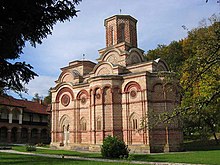
The architectural styles of the previous epochs are retained: cross-dome, four-pillar and courtyard church. The dimensions are becoming more modest and the exterior building receives new, colorful accents through different layers of brick and stone. The cross-domed church remains popular. One of the innovations is that the churches will be moved on three sides with one corridor. Churches are also being rebuilt. In addition, the decorations will be more varied. The buildings are becoming less regular. The joy of large domes grows.
The palaeological renaissance remains of importance mainly through the internationalization of Byzantine art. It is no longer limited to the narrower area of the Byzantine Empire and its artistic centers in Constantinople, Thessaloniki and Mount Athos . Through the transfer to the Slavic countries and the fact that these are often economically and politically more vital than the remnants of the late Byzantine Empire, Byzantine art also opens up new impulses. The architecture, especially in Russia and Serbia, draws on Byzantine models, but developed tendencies, especially after 1375, which noticeably bear a new signature in architecture and painting. In addition to the churches of the Morava School , the innovations in fresco painting of the Palaiological Renaissance are characterized by more individuality, which tends towards a stronger humanism and reinterprets the often schematic specifications.


Reception of Byzantine art among the Slavic peoples
Hardly anywhere else did Byzantine art prove to be as durable as with the Slavic peoples of the Balkans ( southern Slavs ) and Russia ( eastern Slavs ). The fertility manifests itself in local variations, which are particularly evident in the architecture. The established traditions sometimes developed into their own styles of Byzantine architecture, which, as in the Serbian-Byzantine style , go through an independent development and in the last stage of Byzantine art in the 14th and 15th centuries in the Morava school, a model architectural style for neighboring countries give ( Moldavian monasteries , Wallachia ).
In particular, the gradual relocation of the art centers to the Balkan region ( Serbia , Bulgaria ) and to Russia during the late phase of the Byzantine Empire resulted in a permanent artistic stamping of the countries that lasted far beyond the existence of the Byzantine Empire and is still part of the cultural substance of the Countries is.
Many Byzantine artists from Constantinople and Thessaloniki worked at the courts of Slavic royal houses during the Palaiological Renaissance , for example Greek fresco painters designed the numerous royal monastery foundations ( Gračanica ) at the court of the Serbian ruler Stefan Uroš II Milutin . The Byzantine influence was reflected in all the details of the court ceremonial (clothing, title) and legislation. While the Serbian medieval state under Emperor Stefan Uroš IV. Dušan briefly became the main power of the Balkan Peninsula , the Greek influence is a prominent feature of the court, which is modeled on Constantinople. Dušan calls himself the basileus of the Greeks and Serbs. The most mature phase of Serbian-Byzantine art begins with the despot Stefan Lazarević (1404–1427), which, with the Morava School , achieves a courtly quality of architecture that still shapes the style of church architecture in Serbia today.
In architecture, Russian and Serbian churches ( Gračanica , Visoki Dečani , Kalenić ) often follow a modified scheme by emphasizing the vertical , while Byzantine originals have no reinforcement of the vertical component. The architecture in Russia and Serbia takes on influences from the West ( Romanesque , Gothic ), ultimately remaining true to the Byzantine central building with one or less often five domes. Only the buildings of the Raška School show a stronger Romanesque influence in the ground plan ( Studenica Monastery ), but were displaced by the cross-domed structure at the end of the 13th century. The development of architecture, especially in the Balkans, emphasizes the colourfulness of the facades and reinforces the vertical component more and more, so that the stronger dynamics of the church architecture in the original buildings of the Morava school form a crowning glory of the thousand-year-old Byzantine art.
The fresco painting reached between the 13th and 15th centuries in Serbia a high level. With frescoes from the Komnen period in Studenica Monastery (1170) and Sopoćani Monastery (approx. 1265), which were created by Greek fresco painters in great magnificence, the development of this art movement reached a climax. The frescoes of the palaeologists are mostly conservative ( Ohrid , Gračanica ), but attained a new quality in the late phase of the 14th century and first half of the 15th century in the Morava school ( Kalenić , Manasija ).
Icon painting is basically more attached to the Byzantine models. With Andrei Rublev ( Trinity Icon ) an icon painter in Russia will develop his own style, which, as dogmatically exemplary, had to be imitated.

Aftermath in the Ottoman Empire
After the fall of Constantinople in 1453 , Byzantine architecture significantly influenced the Ottoman-Islamic architecture of important mosques, such as B. the Sultan Ahmed Mosque ("Blue Mosque"), which was built on the model of Hagia Sophia . The imperial mosques of the 16th century ( Beyazid II Mosque ) are particularly important, and in the age of Sultan Suleyman the Magnificent by Sinan ( Şehzade Mosque , Suleymaniye Mosque and Edirne Selimiye Mosque ), a constant engagement with the art of Justinian Represent the age. The obsessive examination of the example of Hagia Sophia has contributed to creatively original architectural masterpieces that belong to world art.
Venice and the West


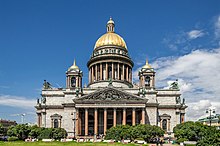
Byzantine cultural influence has also enriched the art of Western Europe at different periods. In particular, Byzantine art is a form of the Mediterranean culture, but France and the German Empire also took up elements of Byzantine art.
In Italy, on the other hand, Byzantine art was partly represented in parallel, especially in panel painting and mosaic art, with the Romanesque and Gothic periods up to the Renaissance . In Venice in particular, the state most closely connected to the Byzantine tradition, which was historically connected to Byzantium as a former colony as well as through close trade contacts and the Venetian possessions in the Levant , there was also a spiritual penetration of society. After the conquest of Constantinople in 1204 by the Crusaders led by Venice during the Fourth Crusade , numerous artists and art treasures came from Constantinople, especially to Venice , such as the Quadriga from the Hippodrome in Constantinople (today on St. Mark's Basilica) or the Pala d'oro (also in St. Mark's Basilica).
Even if purely Byzantine architectural forms asserted themselves in the West, special occasions were usually necessary for them. This is shown by the best-known examples of this, St. Mark's Basilica and the Palatine Chapel . St. Mark's Basilica is built as a shrine in the early Byzantine style of the 6th century. Although this dates from the 11th century, it is based on the exemplary church buildings of Justinian I in Constantinople ( Apostle Church ) and Ephesus (St. John's Church), although the Byzantine builders at the time of the construction of St. Mark's Cathedral had not built any comparable churches for 500 years. This was then also used as a model for other buildings in northern Italy ( Basilica of St. Anthony in Padua ) and for the domed churches in Aquitaine . Byzantine artists also worked in southern Italy for a long time ( palace chapel in Palermo ).
The fact that Byzantine art also had an effect in the Nordic countries can be seen in particular in the Palatine Chapel in the Aachen Cathedral of Charlemagne , which was built after the Basilica of San Vitale in Ravenna , as well as variously in the Ottonian Age ( Ottonian Renaissance ), as Byzantine Forms of central construction in Romanesque church buildings in Cologne ( Great St. Martin and St. Aposteln ) testify to the high reputation of the Middle Byzantine period.
A revival of Byzantine art can be seen in 19th century Romanticism. Thus, in Munich during the Neoclassicism currently I. Ludwig numerous representative buildings with Byzantine style means (fighters capitals , mosaics, barrel vaults ) as the Allerheiligenhofkirche, the main building of the University ( Friedrich von Gärtner ) and for Ludwig II. The Throne Room in Neuschwanstein Castle built been. A planned Byzantine castle (Falkenstein Castle) was no longer implemented.
The most famous neo-Byzantine building is the Sacré-Cœur basilica on Montmartre in Paris . Here, Romanesque and Byzantine elements are combined in an exaggeration of classic forms that has been baptized as the “confectioner's style”. Was used that the neo-Byzantine style in much of Europe for new church buildings, also show the Neo-Romanesque-Byzantine Ludwig church in Munich, as well as the monumental St. Isaac's Cathedral in St. Petersburg , by de Auguste Montferrand built uniting as neoclassical Greek-Byzantine style elements 1818-1858 . As the largest Orthodox church, St. Isaac also has a record that Hagia Sophia once held. The dome alone rises to 102 m.
literature
General Introduction
- Johannes G. Deckers : The early Christian and Byzantine art . CH Beck, Munich 2007.
- Otto Demus : Byzantine Art and the West . New York 1970.
- Otto Demus (Ed.): Byzantium and the West. Studies on the art of the European Middle Ages . Publishing house of the Austrian Academy of Sciences, Vienna 1984.
- Arne Effenberger and Neslihan Asutay-Effenberger: Byzantium. World empire of art . Beck, Munich 2017, ISBN 978-3-406-58702-3 .
Exhibition catalogs
- Kurt Weitzmann (Ed.): Age of spirituality: late antique and early Christian art, third to seventh century . Catalog of the exhibition at the Metropolitan Museum of Art, November 19, 1977, through February 12, 1978. Princeton University Press, Princeton 1979, ISBN 0-87099-179-5
- Byzance. L'art byzantin dans les collections publiques françaises . Musée du Louvre November 3, 1992 - February 1, 1993. Paris 1992. ISBN 2-7118-2606-6
- David Buckton (Ed.): Byzantium. Treasures of Byzantine art and culture from British collections . British Museum Press, London 1994, ISBN 0-7141-0577-5 , ISBN 0-7141-0566-X
- Helen C. Evans (Ed.): The glory of Byzantium: art an culture of the Middle Byzantine Era AD 843-1261 ; [in conjunction with the exhibition "The Glory of Byzantium", held at the Metropolitan Museum of Art, New York from March 11 through July 6, 1997]. Abrams, New York 1997, ISBN 0-87099-777-7 , ISBN 0-87099-778-5 , ISBN 0-8109-6507-0
- Helen C. Evans (ed.): Byzantium: faith and power (1261-1557) ; [in conjunction with the exhibition "Byzantium: Faith and Power (1261-1557)", held at The Metropolitan Museum of Art, New York, from March 23 through July 4, 2004]. New York: Metropolitan Museum of Art; New Haven: Yale University Press 2004, ISBN 1-58839-113-2 , ISBN 1-58839-114-0 , ISBN 0-300-10278-X
architecture
- Slobodan Ćurčić : Religious Settings of the Late Byzantine Sphere . In: Helen C. Evans (Ed.): Byzantium: Faith and Power (1261–1557) . Yale University Press, New Haven 2004.
- Slobodan Ćurčić: Architecture in the Balkans: From Diocletian to Süleyman the Magnificent (300–1550) . Yale University Press, London 2008, ISBN 0-300-11570-9
- Richard Krautheimer : Early Christian and Byzantine architecture . 4th edition, Penguin, Harmondsworth 1986, ISBN 0-14-056168-4 , ISBN 0-300-05294-4
- Cyril Mango : Byzantine Architecture . Belser, Stuttgart 1975, ISBN 3-7630-1703-8
painting
- Hans Belting : Image and cult - a history of the image before the age of art . CH Beck, Munich 1990, ISBN 3-406-34367-8 .
Individual evidence
- ↑ Helen C. Evans (Ed.): Byzantium: Faith and Power (1261–1557) . Pp. 4-63. Metropolitan Museum of Art, New York 2004. ISBN 0-300-10278-X
- ^ Maryan W. Ainsworth: A la facon grèce : The Encounter of Northern Renaissance Artists with Byzantine Icons. In: Helen C. Evans (Ed.): Byzantium: Faith and Power (1261–1557) . Pp. 545-593. Metropolitan Museum of Art, New York, 2004.
- ↑ Jovan Ćirilov: Vizanija NIN, December 2, 1999 Vizantija
- ^ Gabriele Bickendorf: Maniera Greca , Perception and Repression of Byzantine Art in Italian Art Literature since Vasari. Occident and Orient, Istanbul 2002 / in Uni-Heidelberg-Archiv
- ↑ G. Charles Rump: An overdose of heaven - An overdose of heaven-From icon painter to mannerist: The Spanish artist El Greco in the Thyssen-Bornemisza Museum. Welt online, March 3, 1999
- ↑ I Srbi ce doci na red , Helen C. Evans, Kustorin of the Department of Medieval Art at the Metropolitan Museum of Art in New York in an interview with NIN, April 5, 2001
- ^ Claudia Beelitz: Eduard Steinberg. Metaphysical painting between thaw and perestroika Steinberg, Malevič and Morandi
- ↑ Holger A. Klein : Byzantium, the West and the "true" cross
- ↑ Colloquium at the Philosophical Faculty of the University of Cologne, 2008 Colloquium Byzantium and the West. Transfer processes in literature, art and philosophy ( Memento from July 28, 2012 on WebCite ) (PDF; 122 kB)
- ↑ SWR2 Highlights, radio report on the Warhol exhibition in the Byzantine Museum Athens Rediscover Andy Warhol. An exhibition in the Christian-Byzantine Museum Athens ( Memento from December 16, 2009 in the Internet Archive )
- ^ Andy Warhol. Gold Marilyn Monroe (1962) . In: MoMA.org . Retrieved July 28, 2012.
- ↑ Bill Broadway Washington Post Staff Writer, Saturday September 19, 1998; Page C07 A Look at Andy Warhol's Spiritual Side
- ^ A New Start: FT: Andy Warhol's paintings at Grand Palais . xinkaishi.typepad.com. March 27, 2009. Retrieved July 28, 2012.
- ^ Daniel Schreiber: An exhibition in Athens links religion with pop art . monopol-magazin.de. October 27, 2009. Retrieved July 28, 2012.
- ↑ For a detailed description of the picture dispute and the tendentious source reports, see Leslie Brubaker, John F. Haldon: Byzantium in the Iconoclast era. c. 680-850. A history . Cambridge et al. a. 2011.
- ^ Annemarie Weyl Carr: Images: Expressions of Faith and Power . In: Helen C. Evans (Ed.): Byzantium: Faith and Power (1261–1557) . Metropolitan Museum of Art, New York 2004, pp. 143–152.
- ↑ Annemarie Weyl Carr p. 144.
- ↑ Annemarie Weyl Carr p. 143.
- ↑ Kostis Kourelis, Objects-Building-Situations Musings on architecture, art and history with special focus on Mediterranean archeology, August 12, 2008 Quantifying Byzantine architecture
- ↑ Stèphane Yerasimos, p. 83
- ↑ Magdalino, Paul (1987): Observations on the Nea Ekklesia of Basil I . Yearbook of Austrian Byzantine Studies (37): pp. 51–64. ISSN 0378-8660
- ↑ Holger A. Klein: Sacred Relics and Imperial Ceremonies at the Great Palace of Constantinople . In: FA Bauer (ed.): Visualizations of rule . (= BYZAS 5 ). Istanbul 2006, pp. 79-99 ( digitized version ).
- ↑ Holger A. Klein, p. 92.
- ^ Stephan Westphalen : Review of: Lioba Theis: Flanking rooms in the Middle Byzantine church building. For securing findings, reconstruction and meaning of a missing architectural form in Constantinople, Wiesbaden: Reichert Verlag 2005, in: sehepunkte 6 (2006), No. 10 (online)
